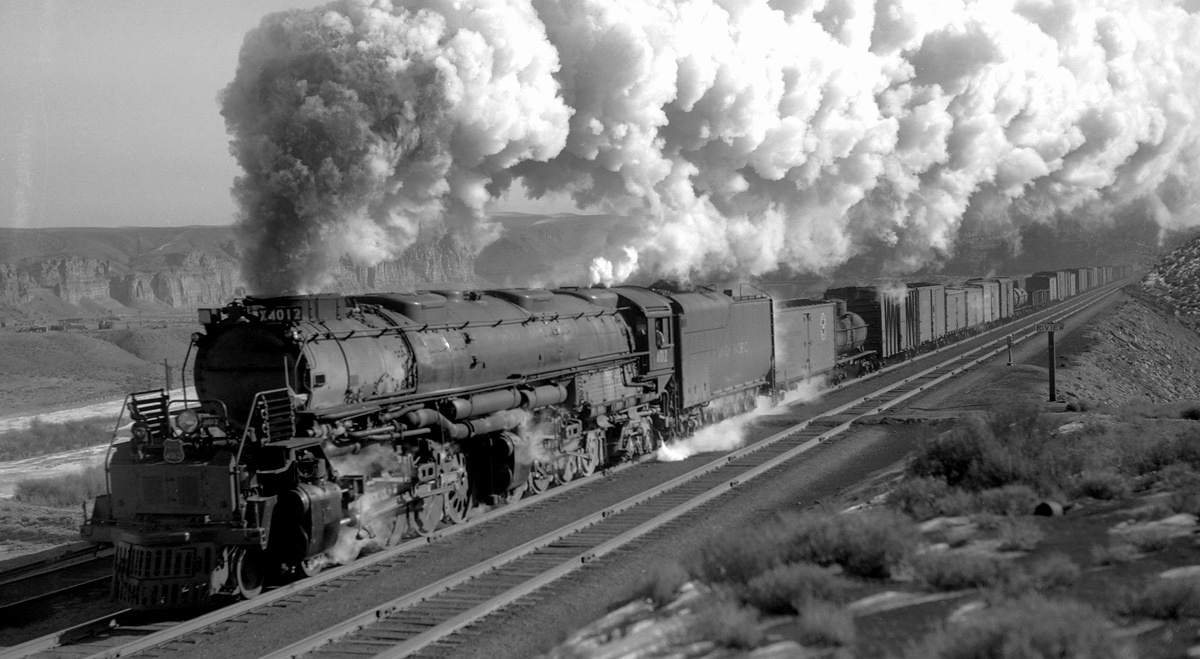Back in my college days I needed summer jobs so I could have enough money for the following school year. In the summers of 1941 and 1942 my Uncle George, who worked for the Union Pacific Railroad Right of Way Department, helped me get a job on a paint gang. The work was hard, hot and dirty, but the pay was good: 58 cents per hour as a painter helper in ’41 and 62 cents per hour as a second-class painter in ’42. I lived cheaply and saved $40 or more each 70- or 80-hour work week.
My first summer the gang painted mostly houses, stations, fences — anything made of wood that was colored Union Pacific brown or Union Pacific yellow that could be reached on a ladder. The second summer the gang painted everything on the right of way made of steel. Everything: bridges, water towers, tanks, turntables; they all got a coating of black coal tar emulsion to slow the rusting. Most of the painting was spray painting done from platforms supported by block and tackle.
There were eight in our gang the second summer — the boss, six old-timers and me; I was youngest by far at 20. The boss, Henry, was in his 50s and had been a boss for 20 years. It was evident that he was a little crippled; somewhere in his past he may have had an accident of some kind.
At a family gathering years after my two summer jobs, Uncle George told me in front of my dad and others, “I worried about you every day you were on that job.” I responded, “Ah, it was nothing.”
Well, it was nothing — if you didn’t count the times I could have been injured or killed.
One such was a hot, humid day in August along the Solomon River branch line in western Kansas. Henry said to me, “Ride with me into the station. I’ve got to order some paint.” A couple of the men helped us drag our eight-man motor car onto the wooden platform and onto the tracks. It had an automobile engine, so we were soon zipping along at a sprightly 20-25 mph. Henry had the timetable for all trains that day, so he knew nothing was scheduled right then for the track we were using. Except his timetable was wrong.
It began to rain. Henry wore a fedora and the breeze bent the brim back flat against his head as he peered ahead through the raindrops on his glasses. I, too, squinted into the rain.
We were approaching a curve maybe a half mile ahead. Suddenly I could see entering that curve and coming our way was a big, black steam locomotive belching smoke from its stack, dragging 30 or 40 freight cars. It was on our track (there was only one track) heading to the straightaway we were on, going maybe 30-40 mph. In only 30 or fewer seconds we were going to meet.
I yelled. Henry yelled and yanked the hand brake and our car stopped. I ran to his side of the car. We grabbed the side of the car, and the two of us raised it up as high as our heads, then with a final shove, sent it off the tracks and tumbling down the roadbed into the ditch. We scrambled off the tracks and followed the car down the embankment.
I turned back in time to look up and see the train pass by, the engineer hanging out the window of the engine cab, looking down at us with no apparent recognition of what had just happened — which was, his life may have just been spared.
When Henry and I calmed down a bit we looked at our predicament. Fortunately, at least the motor car had stopped right side up, but it was 10 feet below the level of the tracks. Cinders had been used for the ballast under the rails, and the loose cinders covered the slope of the roadbed. The motor car was designed to move on steel rails. Those loose cinders were going to be the worst possible surface.
We discovered that by exerting all our strength we could move the car two or three inches at a time. By moving the car at an angle to the tracks our path would be 56 feet through the loose cinders, two or three inches at each shove.
The gang would have known that something was wrong when they saw the freight train go by, but there was no way to know what, where we were or how to get to us if they did. So, they were of no help; we had to move the car ourselves.
It was hot and humid from the rain; the temperature was probably in the mid-90s. Because the job was very dirty I was wearing double clothing as usual: two long sleeve shirts, two bib overalls, a railroader’s cap and gloves. To add to our miseries, we had stirred up a nest of flying ants, and the pesky things were flying into our ears, noses and mouths. The old man wasn’t much of a talker, and he certainly wasn’t this time, so we just grunted and shoved. Over the next few hours we shoved hundreds of times, moving the car a couple of inches each time — until we closed the 50 or 60 feet.
When we finally got the car near the tracks we then faced the task of raising the car onto the rails. (The rails were probably only six inches high because this was a branch line.) We were able to extend the car handles a couple of feet to get a better purchase, so we were only lifting about half the car’s weight to get one wheel at a time on the track.
How much weight did we have to lift to put the car back on the tracks? Even more interesting, how much weight had we lifted when we lifted the car completely off the tracks to avoid a crash?
What did our eight-passenger motor car weigh? 500 pounds? 600? 700? More? How much weight did a crippled 50-year-old man and a light-weight 150-pound kid lift to avoid the train wreck? Had our fear given us extraordinary strength to avoid a sure crash?
When we got back to the job site, of course we told the gang what had happened, but so far as I ever learned there was never a report of the near-miss by Henry or the train crew (or Uncle George, for he would certainly have known!). As far as the Union Pacific railroad was concerned, it never happened. And Henry and I kept our jobs, which, had it been otherwise, would have been inconvenient for me but career-ending for Henry.









